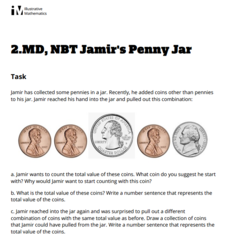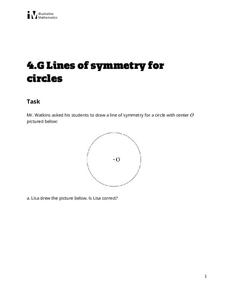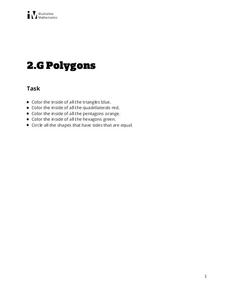Illustrative Mathematics
Making 124
How many ways can you make the number 124 using only tens and ones? Use a task that prompts young mathematicians to make 124 in as many ways as possible.
Illustrative Mathematics
Double Plus One
Practice doubling with a straightforward worksheet. Learners double plus one each number in the table, and then answer a series of hypothetical math equations.
Illustrative Mathematics
Expanded Fractions and Decimals
Complete the table by writing mixed numbers in expanded fraction and decimal notation. A versatile resource is a great addition to your fourth grade curriculum!
Illustrative Mathematics
Peaches
Subtracting mixed numbers is easy when the fractions have the same denominator. Here, young mathematicians are prompted to find out how many pounds of peaches are left after Alfredo gives some pounds to his neighbor.
Illustrative Mathematics
Fraction Equivalence
Why is six-tenths equivalent to sixty-hundredths? This is the question learners are tasked to explain in writing as well as with a picture.
Illustrative Mathematics
One, Ten, and One Hundred More and Less
What's 1 more or less than a number? What's 10 more or 10 less than a given number? What's 100 more or 100 less than a number? These are the types of problems learners must answer in a six-question worksheet.
Illustrative Mathematics
What's the Point?
Given a certain amount of points, how many line segments can you connect between them? How many close geometric figures can you create? These are the types of questions learners are asked to solve in a assessment-based learning exercise.
Illustrative Mathematics
Saving Money 2
Adding money is a key skill in life. Give a worksheet that requires second graders to find the total amount of money Louis needs to make certain school supply purchases.
Illustrative Mathematics
Regrouping
What number does 6 tens and 16 ones represent? How is it different from or similar to the number that 7 tens and 6 ones represent? This is the type of questions learners are asked to solve as a way to understand the concept of regrouping.
Illustrative Mathematics
Red and Blue Tiles
Here, second graders are tasked to find the patterns that have an even number of tiles. They are asked to think about why these patterns are even or odd and explain how they know.
Illustrative Mathematics
Comparing Sums of Unit Fractions
First, add each set of fractions with unlike denominators. Then, compare their sums with the symbols <, >, or =.
Illustrative Mathematics
Largest Number Game
Learners are asked to make the largest three-digit number they can with the numbers 1, 8, and 5 in a quick assessment worksheet.
Illustrative Mathematics
Digits 2-5-7
Given three digits, what is the largest humber you can make? What is the smallest number you can make? These are the questions second graders are prompted to answer in a three-question quiz.
Illustrative Mathematics
Bundling and Unbundling
Seven tens, plus five ones, equals 75. Five ones, plus seven tens, also equals 75. These are the types of equations learners are asked to make true in a worksheet with 11 unfinished equations.
Illustrative Mathematics
Jamir's Penny Jar
Before you start counting the coins in Jamir's coin jar, figure out which coin to start with. Should it be the penny or the quarter? Why? This is the focus around a learning exercise that works well as an assessment on counting money and...
Fluence Learning
Writing a Narrative: How Bear Lost His Tail
After reading the first, second, and third parts of "How Bear Lost His Tail", third grade writers answer questions about the story by completing a series of options, including discussion points. Then, they begin to plan a new narrative...
Illustrative Mathematics
Lines of Symmetry for Circles
Further your instruction on geometrical symmetry with an investigation of circles. Fourth graders come to realize that the lines of symmetry of a circle are infinite.
Fluence Learning
Writing Informational Text: Lemonade Stand
Use a performance task to assess third graders' ability to read informational text. After they plan a lemonade stand business, young entrepreneurs implement that plan through informational writing. The task assumes learners can...
Illustrative Mathematics
Which Pictures Represent One Half?
Which image represents one half? Answer the question surrounding four shapes, some of which represent one half and others representing a different amount. The last two questions ask learners to explain why some shapes represent one half...
Illustrative Mathematics
Representing Half of a Rectangle
Did you know one half of a rectangle be represented in more than one way? Young mathematicians choose the rectangles that represents one half with an instructive worksheet.
Illustrative Mathematics
How Many Tenths and Hundredths?
Four hundredths + one tenth = 14 hundredths. Learners complete place order equations in order to make each equation true. Hundredth and tenths are the focus of the worksheet.
Illustrative Mathematics
Comparing Money Raised
How much money did Helen, Sandra, Nita, Luis, and Anthony raise? Compare their amounts with a task that asks learners to answer questions like how many times as much?
Illustrative Mathematics
Counting Dots in Arrays
Mathematical arrays can represent several different math skills, including counting groups, multiplication, and even area. In this specific task, learners are asked to identify the addition equations that are equal to a 3 x 4 array....
Illustrative Mathematics
Polygons
Identify shapes based on their attributes. Second graders are tasked to color triangles, quadrilaterals, pentagons, and hexagons specific colors. The one thing these shapes have in common? They are all polygons.

























